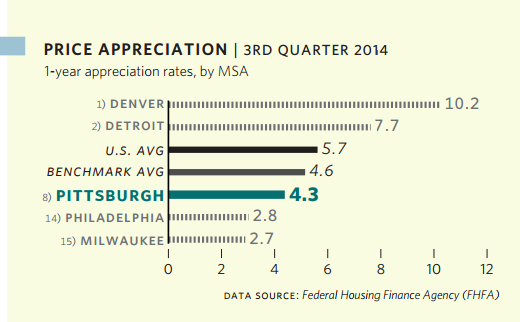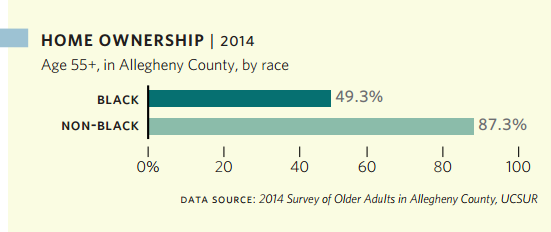Land banks emerge with hopes of turning back the tide of vacant properties
They were aware of the problem. How could they not be? The ghostly abandoned houses and weedchoked vacant lots in their municipalities numbered in the thousands. Vacancy, tax delinquency and blight had emerged as widely recognized cancers exclusive to no neighborhood. The crisis even resonated in Harrisburg, where lawmakers were drafting legislation to help fight its spread.
What the Steel Valley, Twin Rivers and Turtle Creek Valley councils of government didn’t know back in 2012 was the cost of doing nothing about it. They decided to find out and commissioned a study to determine the financial impact of vacancy and blight in the 41 municipalities they represent in the east suburbs of Pittsburgh.
The answer was enough to give officials in even the wealthiest of communities sticker shock: Vacant lots and blighted structures are collectively costing cities, boroughs and townships nearly $255 million a year in municipal services, lost tax revenue and eroded property values.
“That changed the way we discuss vacant, blighted and abandoned properties,” says Turtle Creek Valley Council of Governments Executive Director Amanda Settelmaier. “The decision makers understand what it’s costing them.”
Last summer, the three councils of government finished a business plan for creating a land bank. It’s one of the first to emerge in southwestern Pennsylvania in the wake of a state law that allows municipalities, community development corporations and others to use what is considered to be the most promising tool yet for dealing with vacant and blighted property on a large scale.
Last April, a new ordinance also opened the door for the City of Pittsburgh to establish a land bank to address its vacancy-related issues, not the least of which is how to turn around the 7 percent of city residential property that is both tax-delinquent and abandoned.
Scaling up
Local governments and community groups have long waged war against blight. But the means for doing so – usually traditional tax foreclosure processes – are cumbersome and have limited land recycling to a few hundred parcels a year in a region where tens of thousands stand vacant.
One obstacle is the tedious process that’s often necessary for a buyer to acquire a property. In Pittsburgh, for example, it can take two or more years for the title of a single property to be cleared before it can go to treasurer’s sale. Even then, buyers have no guarantee they won’t be outbid at auction after investing time and money to pursue it.
The lack of an effective means of packaging, marketing and selling vacant and abandoned properties also has led local governments to shy away from acquiring parcels without a committed buyer attached to avoid the risk getting stuck with them.
Land banks are gaining in popularity across America as a way to address such obstacles after early experiments showed some success in places struggling to stem the rise of vacancyand blight, such as Flint, Mich., and Cuyahoga County, Ohio.
A land bank has the potential to streamline the buying process by assembling portfolios of ready-to-sell, reasonably priced properties with titles cleared and back taxes forgiven under agreements with school districts, municipalities and other taxing authorities. Land banks in other states also have been coupled with land recycling strategies tailored to neighborhoods.
“They have to be thoughtful about all of those pieces, and there is a community revitalization role in what they do,” says Bethany Davidson, who works with local governments and others on land recycling issues as deputy director of the nonprofit Pittsburgh Community Reinvestment Group. “A land bank might own 100 properties in a neighborhood, but putting all 100 up for sale is not always the best idea. That could flood the market and depress values, which wouldn’t help lift up the people who live there now or improve their equity and property values.”
Pennsylvania law allows land banks to acquire property in several ways, including tax foreclosure, purchase and donation. They can then sell, rent, raze or rehabilitate those properties. To sustain themselves, land banks can raise money through bonds, sales, rent and by sharing tax revenues with local governments once the properties shed their delinquency status.
But land banks are complex, and creating one is not simple. A key challenge is navigating local politics, sometimes across municipal borders, to gain cooperation and set policies and procedures for acquiring and disposing of vacant and abandoned properties, financing operations, sharing revenues and forgiving delinquent taxes to make vacant parcels more attractive to buyers.
Exposing the hidden cost of derelict property proved to be an important selling point when the Steel Valley, Twin Rivers and Turtle Creek Valley councils of government, through theirTri-COG collaborative, went on the road last year to convince 41 municipalities and a half-dozen school districts that creating and joining a land bank is the way to go.
Cost of blight
Vacant and blighted properties corrode neighborhoods in many ways. The eyesores that blighted properties become are the most noticeable. Less apparent are costs ranging from dysfunctional housing markets, lost tax revenues and municipal costs to health and safety risks and the burdens they impose on the already challenging job of revitalizing depressed neighborhoods.
The Tri-COG assessment of those costs in the east suburbs of Allegheny County, one of only a handful done in the state and nation, offers insight into the impact of vacant, tax delinquent and abandoned property in southwestern Pennsylvania.

More than 20,000 vacant lots and nearly 7,200 blighted structures were identified in the COGs’ municipalities. Their financial impact is realized in both direct and indirect costs estimated at more than a quarter of a billion dollars each year.
The derelict properties cost the municipalities $10.7 million a year for police and fire, code enforcement, public works and demolition services. Lost tax revenue robs municipalities of another $8.6 million.
But the biggest losses are seen on the value of the properties closest to blight. More than 28,000 properties were found to be within 150 feet of blight, and their total value dropped by$218 million, according to estimates based, in part, on studies that suggest having a blighted neighbor lowers property values by 15–17 percent. If that isn’t bad enough, depressed property values cost the municipalities more than $8.5 million in real estate taxes each year.
Local governments stand little chance of making a dent in such numbers, given the time and money it takes to do so. In Clairton, for example, it was determined that addressing the 247 vacant properties identified in a single neighborhood meant having to deal with more than 150 different property owners and incur costs of up to $5,000 per property to clear the titles.
“It comes down to site control,” says Steel Valley Council of Governments Executive Director An Lewis. “You need an entity with the time and resources to assemble properties for redevelopment. That’s what a land bank does. Many of our municipalities are small. They don’t have the capacity to do that on their own.”
Few places have been untouched by the spread of vacant, abandoned and blighted properties.
Some 10.2 percent of housing is vacant in the seven-county Pittsburgh Metropolitan Statistical Area, according to 2013 U.S. Census Bureau data, a measure of homeowner and rentalvacancy that doesn’t include condemned houses. That’s the fourth highest vacancy rate among the 15 Pittsburgh Today benchmark regions. Armstrong County has the highest rate in the MSA with 11.7 percent of its housing vacant. And in Allegheny County, more than 55,000 housing units were vacant when the 2010 decennial census was taken.
Those data also identify 12.8 percent of the housing in Pittsburgh as vacant, with much higher rates found in many of the city’s most distressed neighborhoods.
Nearly 1-in-5 houses in Hazelwood stood vacant in 2010; the median sales price of a home had fallen to $5,700; and 41 percent of taxable property was tax-delinquent—twice the citywide average. In Homewood, nearly 44 percent of the land parcels and 30 percent of houses were identified as vacant in a University of Pittsburgh University Center for Social and Urban Research study.
Land banks take root
Once the cost of blight was documented in the east suburbs, Tri-COG staff spent the better part of 18 months drafting a business plan with legal support from a local attorney with land banking expertise. Municipal officials were consulted. Draft ordinances were written. And municipalities began signing on as early as last fall.
Pittsburgh’s land bank was slow getting out of the gate. The city’s land bank ordinance named an interim board and charged it with drafting policies and procedures, but did not designate how it should function. The board didn’t hold its first meeting until about halfway through its 90-day term. And it was unable to convene enough members for a quorum on several occasions.

By year’s end, most of the details necessary to launch the land bank had not been fleshed out. “We couldn’t get the train out of the station on something as important as this,” says Jerome Jackson, executive director of the Homewood community organization, Operation Better Block, and one of the interim land bank board members.
The land banks being created in both the city and Allegheny County’s eastern suburbs are expected to begin operations sometime this year.
And the timing is right for taking an aggressive approach to combat blight, says John Kromer, a landbanking expert with the University of Pennsylvania’s Fels Institute of Government and a former Philadelphia housing director. “This is an exciting time in Pennsylvania, in part, because real estate in depopulated, disinvested cities and towns is becoming more valuable. It wasn’t that long ago when you couldn’t give away lots and buildings that are now in demand.”






